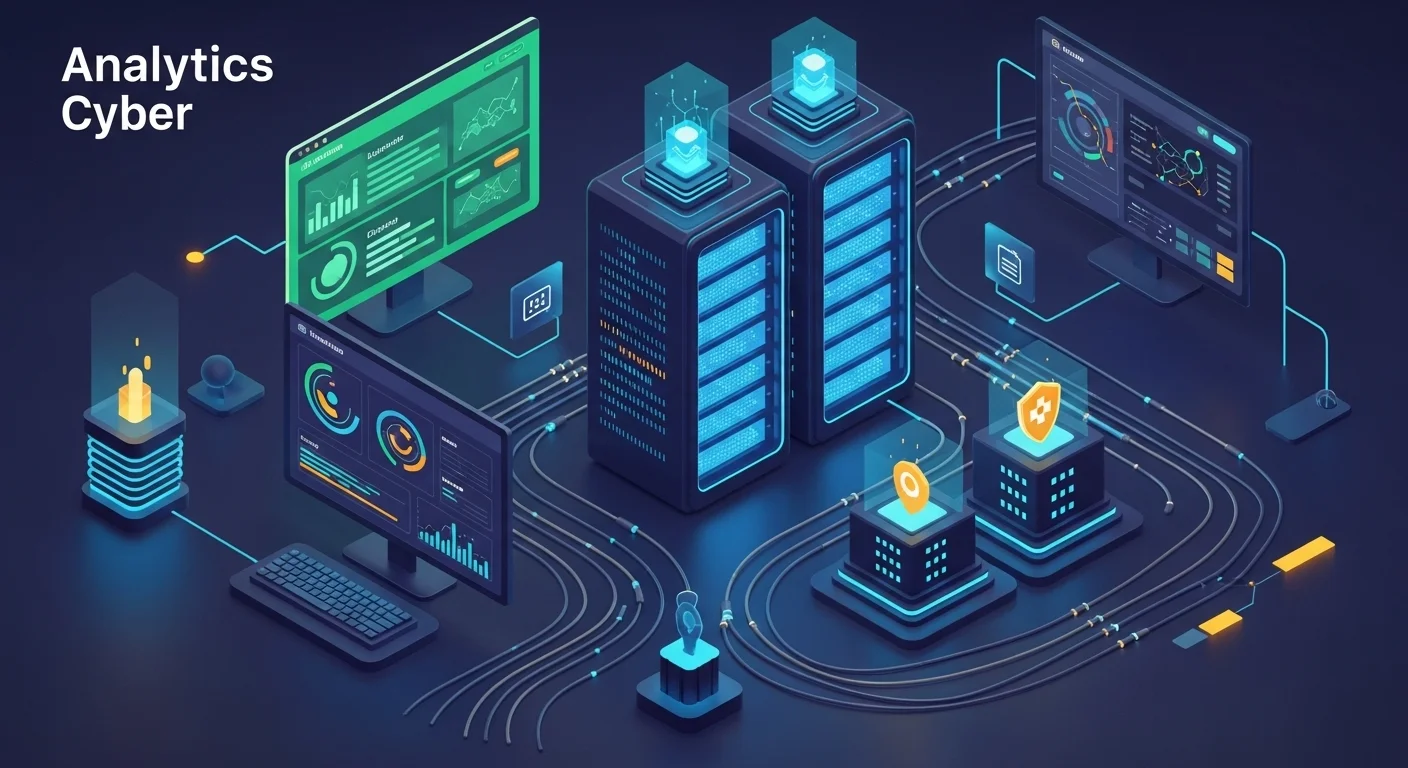Cyber Analytics Explained: How Data is Your Best Defense in Tech Security

Executive Summary
In my years working in cybersecurity, I've seen countless businesses get overwhelmed by an endless flood of security alerts. The real game-changer? Cyber analytics. It’s not just about collecting data; it’s about turning all that digital noise into clear, actionable signals that can stop threats cold. This guide is my way of breaking down how you can shift from being a constant target to being a digital fortress, simply by using the data you already have. We'll walk through how this technology works, why it's absolutely essential for any modern business, and how you can start making it work for you.
Table of Contents
What is Cyber Analytics and Why Does It Matter?
In a world where our businesses run on data, protecting our technology has become paramount. I've spent my career on the front lines of this battle, and I can tell you that the nature of the fight has changed. That's where Cyber Analytics comes in. Think of it as the next evolution of digital defense. At its heart, cyber security analytics is all about applying smart data analysis to the massive amounts of information our security systems generate every second. The goal is simple: find, predict, and stop cyber threats faster and more accurately than ever before. Traditional cybersecurity tools are like a bouncer with a list of known troublemakers—they're great at stopping threats we've seen before. Cyber analytics, on the other hand, is like having an experienced security chief in the room who can spot trouble just from someone's unusual behavior, even if they've never been on any list. It’s the science of finding the hidden threats in a sea of digital activity.
The importance of this technology is rooted in how complex our IT worlds have become. Businesses today are a sprawling mix of cloud servers, office networks, IoT gadgets, and employee laptops. Every single component creates a torrent of data—logs, network traffic, user actions. No human team could ever sift through all of it. This is where the magic of combining data analytics and cyber security happens. By using big data tools and artificial intelligence, we can automate the analysis of this information in real-time. This allows security teams like mine to switch from just reacting to problems to actively hunting for them. We can spot odd behaviors that signal an impending attack and even predict where we might be vulnerable next. It's about getting ahead of the problem for once.
The Core Ideas Behind Security Data Analytics
To really get what cyber analytics is about, you need to understand its key ingredients. This field isn't a single tool but a whole system of technologies working together. It all starts with gathering data from everywhere: your firewalls, your servers, your user activity logs, and even external threat intelligence feeds. This is the raw material for our analytical engine. Once we have it, we use platforms like SIEMs (Security Information and Event Management) to organize and prepare it for analysis.
Then comes the fun part, where the power of data analytics in cyber security truly comes to life. We use a few different lenses to look at the data:
- 'What happened?' (Descriptive Analytics): This is your basic dashboard, showing things like failed login attempts or traffic from a weird location. It gives you a snapshot of the current situation.
- 'Why did it happen?' (Diagnostic Analytics): This goes a step deeper. If we see a spike in failed logins, this type of analysis helps us figure out if it was a coordinated attack or just a broken app.
- 'What will happen next?' (Predictive Analytics): This is where we get proactive. By looking at past trends, we can build models that predict, for example, which of our servers is most likely to be targeted next, allowing us to bolster its defenses ahead of time.
- 'What should we do about it?' (Prescriptive Analytics): This is the most advanced stage. It doesn't just predict an attack; it recommends specific actions, like blocking certain IP addresses or locking a user account to stop the threat before it starts.
Technologies like machine learning (ML) are the engine driving all of this. It's incredibly powerful for spotting anomalies—deviations from 'normal' behavior—which is how we catch brand-new attacks and even threats from within the company. Using analytics in cyber security effectively turns your raw data from a liability into your most valuable strategic asset for making smart security decisions.
Real-World Business Applications and Tangible Benefits
In a business setting, the impact of cyber analytics is huge. One of the biggest wins I've seen is in threat hunting. Instead of waiting for an alarm to go off, my team can use these tools to proactively search for subtle signs of an advanced attack. This drastically cuts down the time an attacker can remain hidden in a network, which minimizes potential damage. Another game-changer is User and Entity Behavior Analytics (UEBA). These systems learn the normal activity patterns for every user and device. So, when an accountant's login is suddenly used to access engineering files at 3 AM from a foreign country, the system immediately flags it as a high-risk event. A simple signature-based tool would completely miss that.
The benefits for businesses that embrace a solid cyber analytics program are clear and compelling. First and foremost, you get a much stronger security posture. Catching threats faster means you dramatically lower your risk of a data breach, which can save millions in fines, fees, and reputational damage. From my experience, the ROI on a good data analytics and cyber security program is undeniable. It also makes your security team more efficient. By automating the grunt work of sifting through data, analysts are free to focus on what humans do best: strategic thinking and complex problem-solving. This keeps them engaged and prevents burnout, which is a huge issue in our field. Finally, it makes proving compliance with regulations like GDPR or HIPAA much easier, as you have detailed logs and reports at your fingertips. Ultimately, smart use of analytics in cyber security allows a business to innovate and grow with confidence, turning cybersecurity from a cost center into a powerful business enabler.

Your Complete Guide to Implementing Cyber Analytics in Your Business
So, you're ready to bring the power of cyber analytics into your organization. That's a great decision. But it's more than just buying a new piece of software; it's about building a program that weaves together people, processes, and technology. I've guided many companies through this journey, and I've found that a methodical approach works best. This is your roadmap to creating a formidable defense against modern digital threats. The absolute first step is getting your data house in order. The guiding principle I always tell my clients is, 'You can't protect what you can't see.' You need to identify and pull in data from every corner of your tech environment. This means logs from firewalls and servers, data from employee laptops (via EDR tools), network traffic patterns, and, crucially, logs from your cloud services like AWS or Azure. Tying this all together with external threat intelligence feeds gives your internal data context, making your cyber security analytics exponentially more powerful.
The Technical Nitty-Gritty: How It Actually Works
With data flowing in, we can get to the heart of the matter: the analysis. This is where we turn that raw data into actual security intelligence. The core of this is often a modern Security Information and Event Management (SIEM) platform, supercharged with AI and machine learning. Here’s a breakdown of the stages I walk teams through:
- Data Cleanup and Organization: Data comes in all shapes and sizes. The first technical hurdle is to get it all into a single, common format. This is what allows us to connect the dots between an event on a firewall and an action on a user's computer.
- Connecting the Dots with Rules: This is a foundational technique. We create rules to look for specific sequences of events that spell trouble, like a hundred failed logins followed by one success from an unusual location. It's effective for spotting known attack patterns.
- Finding the 'Weird' with Statistics: Here, we move beyond simple rules. The system learns what 'normal' looks like for every user and server on your network. When something deviates significantly from that baseline—like a server that never talks to the internet suddenly trying to—it gets flagged as an anomaly. This is a cornerstone of effective cyber data analytics.
- Unleashing Machine Learning (ML): This is where the real advanced work happens. ML algorithms can automatically find new types of suspicious behavior without being told what to look for. It's how we find brand-new threats that no one has ever seen before. In my experience, this is the most critical part of a modern data analytics in cyber security practice.
- Focusing on Behavior (UEBA): User and Entity Behavior Analytics puts all of this into context. It asks not just 'what happened,' but 'who did it?' and 'is that normal for them?' This helps distinguish between a legitimate but unusual action and a truly malicious one.
These methods aren't used in isolation; they're layered to create a deep, resilient analytical strategy. Getting this combination right is what separates a basic logging setup from a true analytics in cyber security powerhouse.
Strategy and Implementation: Making It Work for Your Business
Remember, technology alone won't solve your problems. A successful cyber analytics program depends heavily on business strategy. My first piece of advice is always to define your goals. What are you trying to protect against most? Insider threats? Ransomware? Start with a couple of clear, high-priority use cases. This helps the team focus and show results quickly. Building the right team is just as important. You need your traditional security analysts, but you also need data scientists who can tune the ML models and data engineers to manage the information pipeline. Fostering a culture where these folks talk to each other—and to the rest of the business—is non-negotiable.
I always recommend a phased rollout. Start with a 'quick win' project to prove the concept, like monitoring your most privileged user accounts. Once you've shown success, you can expand the program. And make sure you measure your progress. Track metrics like how long it takes you to detect and respond to a threat (MTTD and MTTR). Seeing those numbers go down is a clear sign your investment is paying off. When it comes to tools, you have options, from all-in-one commercial platforms to building your own with open-source tools. The right choice depends on your budget and in-house expertise. Whichever path you choose, the key is to strategically integrate the principles of data analytics and cyber security into how your organization manages risk. This journey is a marathon, not a sprint. It requires ongoing investment and adaptation, but the result is a company that is fundamentally safer and more resilient.

Pro Tips: Mastering Cyber Analytics to Enhance Your Security
Successfully weaving Cyber Analytics into your business isn't a one-and-done project. From my experience, it's a living process of constant learning and strategic adjustment. It's about creating a security ecosystem that grows and adapts right alongside your company and the ever-changing threat landscape. Here, I want to share some practical tips and best practices I've picked up over the years to help you move from simply having the tools to truly mastering them. The first and most important tip I can offer is to prioritize data quality over sheer quantity. It's a common rookie mistake to just turn on the firehose and try to collect everything. This usually creates a 'data swamp' where valuable insights are lost in a sea of noise. Instead, be strategic. Start with your most critical assets. Identify the data sources that give you the most bang for your buck—authentication logs, DNS queries, and cloud activity logs are great places to start. Make sure this data is clean and enriched with context. A smaller, high-quality dataset will give your cyber security analytics platform much clearer signals to work with.
Best Practices for a Mature Analytics Program
To take your program to the next level, here are some practices I've seen work time and again:
- Be Driven by Use Cases: Don't try to solve every problem at once. A fantastic resource here is the MITRE ATT&CK framework, which is basically a catalog of hacker techniques. Pick a technique relevant to you, like 'Credential Dumping,' and focus your analytics on detecting that specific behavior. This iterative approach ensures your data analytics and cyber security efforts are always tied to real-world threats.
- Make Collaboration a Habit: Security isn't an island. It's a partnership between your security analysts, data scientists, IT team, and business leaders. When an anomaly pops up, an IT admin can quickly tell you if it was part of a planned update, saving hours of investigation. This collaborative context is gold.
- Automate Your Responses: The insights from your analytics are only useful if you can act on them fast. This is where Security Orchestration, Automation, and Response (SOAR) tools are a godsend. When your system detects a malicious connection, a SOAR playbook can automatically block the IP, isolate the machine, and create a ticket for review. This frees up your human experts to focus on the truly complex issues.
- Always Be Tuning: Threats change, and so does your business. Your detection models need constant refinement. Set up a regular feedback loop where analysts review alerts and help retrain the machine learning models. This is the hallmark of a mature analytics in cyber security program. It ensures you stay effective over the long haul.
Advanced Tools and Quality Resources
Beyond your core SIEM, tools like Network Detection and Response (NDR) can give you incredible visibility into what's happening on your network. For those of you heavily in the cloud, Cloud Security Posture Management (CSPM) tools are a must-have. If you want to go deeper, I highly recommend the resources from the SANS Institute and the NIST Cybersecurity Framework.
Let me leave you with a quick story. I worked with an e-commerce company that was seeing slow performance but couldn't figure out why. Their traditional tools were silent. But their new cyber security analytics platform flagged a tiny, almost invisible anomaly: a legitimate server process was quietly using a small fraction of its power to connect to an unknown server. Turns out, it was a sophisticated cryptomining malware designed to stay under the radar. By acting on that insight from their data analytics in cyber security platform, they cut out the infection before it could cause real damage or open the door to a bigger attack. That's the real-world power of this approach. By embracing these strategies, you can transform your security from a defense into a strategic advantage.
Expert Reviews & Testimonials
Sarah Johnson, Business Owner ⭐⭐⭐
The information about Analytics Cyber is correct but I think they could add more practical examples for business owners like us.
Mike Chen, IT Consultant ⭐⭐⭐⭐
Useful article about Analytics Cyber. It helped me better understand the topic, although some concepts could be explained more simply.
Emma Davis, Tech Expert ⭐⭐⭐⭐⭐
Excellent article! Very comprehensive on Analytics Cyber. It helped me a lot for my specialization and I understood everything perfectly.



